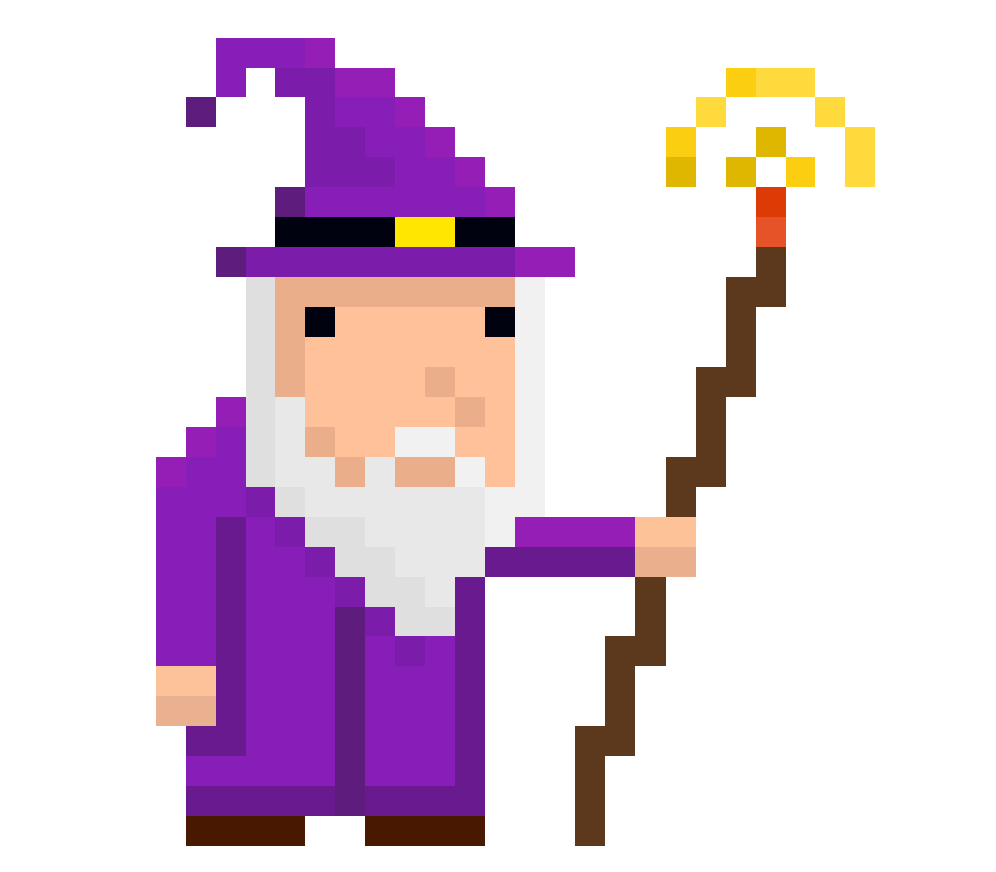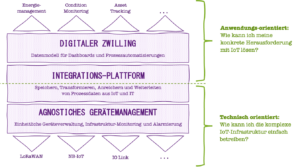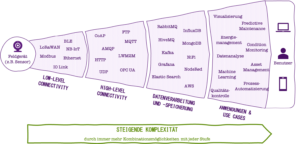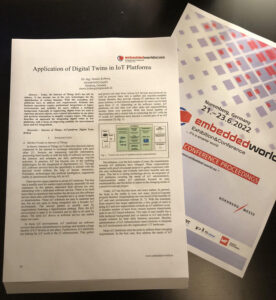Over the years, the Internet of Things (IoT) sphere created a lot of similar terms with similar meanings. Although we are already talking for more than 30 years about IoT, there is still no clear and catchy description. Today, it gets even worse: with Industry 4.0 and Digitalization new technologies and terms occurred within shortest time. And especially in businesses, I see a lot of people playing around with the terms the wrong way. Many get it wrong — or don’t even know that there is a difference. Are you aware of what IoT, IIoT, and AIoT stand for?
Internet of Things (IoT)
IoT goes back to the year 2002 when Kevin Ashton published it for the first time in Forbes magazine [1]. From his point of view, IoT describes a way that makes computers understand the real world. In comparison to today’s understanding, this is a very vague description and doesn’t mention anything about sensors and actuators.
Nowadays, the most common understanding of IoT is the connection between physical objects (“things”) and a communication network (“internet”). Things are equipped with sensors and computing power to exchange data with other things through a communication network. [2] A better description than before, because we get an understand what a thing could be and should be able to do. And a definition that the International Telecommunication Union (ITU) uses since 2012. So rather accepted by a broad community. In addition, the ITU highlights the fact that anything (physical and virtual) can communicate with each other as the novelty of IoT [3].
Nevertheless, for someone who is not caring for scientific definitions and wants to bring IoT into action, this is still meaningless. Personally, I prefer an easier way to describe IoT — with a short “manual” on how to turn an object into an “IoT-thing”:
- Identify a daily used object that is not “digitalized” yet (e.g., your doorknob)
- Equip it with sensors and/or actuators, so that it can measure and act with its environment (e.g., a motor for opening the door)
- Equip it with a small computer and a (wireless) internet connection, so that it can store data in the cloud and exchange data with others (e.g., an Arduino board that can communicate with your smartphone)
Et voilà, you have realized your first IoT use case! You might have noticed: IoT is neither limited to a certain domain, nor to a certain technology. And it doesn’t necessarily require new technologies. It is more a paradigm that describes how digital systems interact with the physical world. Besides, it can be applied to and solve anything.
For example, IoT can turn your home into a smart home. The heating can be automatically controlled according to the inside temperature, the blinds can automatically open and close themselves according to the outside brightness and your bathroom scales can measure your weight and report it to a website for displaying it on your mobile. But IoT can also turn your city into a smart city. The level of trash cans can be measured to improve the routing of garbage trucks, water pipes can be supervised with sensors to detect leakages, and sensors on parking lots can improve traffic guidance during events.
Industrial Internet of Things (IIoT)
But if IoT already covers such a broad area of applications, what is IIoT then? According to Wikipedia, IIoT is based on fancy technologies such as cyber-physical systems, edge computing, and artificial intelligence (AI). Personally, I have strong doubts about this description. First, we still talk about IoT — although all these technologies are related to IoT, they are not IoT. Second, the term IIoT is older than edge devices and occurred even before today’s hype for AI. How can these technologies be an enabler for IIoT then?
Luckily, there are already some more reliable descriptions of IIoT available. According to the World Economic Forum, IIoT is the industrial application of IoT [4]. This goes along with many other descriptions from science and industry [5] and is (at least to me) more consistent.
Again, we can keep things simple by providing a “manual” for creating IIoT solutions:
- Identify a machine, equipment, or something else in your manufacturing plant (e.g. an old-school drilling machine)
- Equip it with sensors and/or actuators, so that it can measure and act with its environment (e.g. retrofit a vibration sensor on the machine)
- Equip it with a small computer and a (wireless) internet connection, so that I can store data in the cloud and exchange data with others (e.g. a raspberry pi that forwards the processed information to your maintenance planning system)
Again: Et voilà, you have realized IIoT! Of course, doing IIoT is a bit more complicated than doing IoT. You have higher technical complexity and consider much more parties and company guidelines in comparison to doing IoT at home.
For example, IIoT can help you to measure the vibrations of motors to detect upcoming breakdowns before they happen. With IIoT, you can also do quality checks of your products to fine-tune machines based on these checks as well as to measure the machine’s stock to automatically order new primary material for production.
In contrast to IoT, in IIoT the domain of application is limited (industry), but the idea of connecting things via internet connection still applies. So IIoT is a subset of IoT. In practice, this usually also implies different technical approaches. E.g., different architectures and field devices. In contrast to Industry 4.0, IIoT is more a part of Industry 4.0 besides many others like AI, augmented reality, or cobots. IIoT paves the infrastructure for connecting everything in Industry 4.0.
Artificial Intelligence of Things (AIoT)
If IIoT is a subset of IoT, one could assume that AIoT is a subset of IoT, too. Wrong! AIoT is the combination of AI and IoT. The term is rather young and was coined somewhen around 2019 (see e.g. [6]). It is often used as a buzzword, unfortunately. Nevertheless, the idea of combining AI and IoT is almost 10 years old (see e.g. [7]).
In general, AI and IoT can be combined in two ways:
- One AI for many IoT devices: Deriving conclusions from a huge amount of real-life data gathered through IoT sensors can be overwhelming for the human brain. Think of a smart city where traffic lights, parking lots, and streets are equipped with sensors: How can you quickly analyze thousands of data sets to decide if you need to change the routing of cars in the city? Or a production plant where each and every machine as well as equipment process data about the condition of a product: How do you want to figure out what is the cause of a quality issue if you have to analyze it all manually? A central AI-based system can support you to find patterns and abnormalities.
- AI on each IoT device: In contrast to a central AI, one could also use AI on each device. This is useful if you cannot ensure a stable or fast network connection to a central AI system, e.g. in rural areas. Or in retrofitting cases, where you want to equip your machine with a very tailored AI solution (e.g., predictive maintenance implemented in an electrical motor of a certain vendor), but you want to have the least possible intervention. Besides, this way of AI is also used for federated learning (see [8]).
Of course, even a combination of a centralized AI system using the data processed by the AI on devices is possible. Anyway, providing a hands-on-manual how to use AIoT is a bit more complicated:
- Equip a real object with a bunch of sensors and/or actuators (e.g. in your smart city, traffic flow sensors in each street)
- Gather all data in one place (e.g. “the cloud”) and harmonize and enrich it, so that the AI can work with it.
- Set up your AI (e.g. “in the cloud”) and train it with sample data, so that it gives you the answer you need from the data (e.g. “how should I control traffic lights based on the traffic flow to avoid traffic jams?”)
Guess what? Et voilà, now you have realized AIoT! Maybe it is not that easy: to use the full power of AI, you need knowledge in algorithms and how to use them, too. Besides, in practice, harmonizing and enriching data from various heterogeneous sources for AI can be very challenging. It is not “just using big data”. And you might have noticed it: the first step of utilizing AIoT is always doing IoT.
Same same, but different?
If IoT describes a new technology, maybe even a new paradigm, IIoT is a subset of it that focuses on the industry domain. That means, that the technology is the same, but the place where it happens is different. In contrast, AIoT is a combination of two new technologies — independent from the domain. It puts together IoT and AI, like building bricks that create together something new.
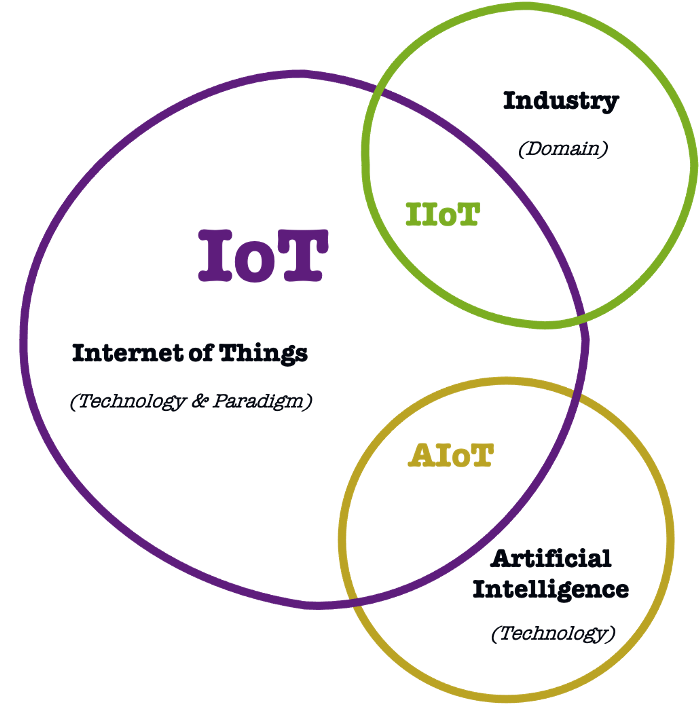
From the technology point of view, AIoT might be the most powerful tool in your toolbox. But it is also the most demanding and only valuable for certain use cases. Whereas IoT-based solutions are easier to set up, especially because every AIoT solution always requires IoT as a first step.
From the market point of view, the demand for IoT is still way above the demand for IIoT and AIoT, at least according to Google’s search inquiries [9]. AIoT and IIoT have almost the same level of search inquiries, whereas IoT is more than 30 times higher. This huge difference can have several reasons:
- We are still in an IoT world and the users are not ready for AIoT and IIoT yet. Maybe that’s right for the young term AIoT, but not for IIoT in my opinion.
- The users of IoT don’t even know about AIoT yet. Maybe due to a lag of marketing, but maybe due to a lack of market-ready solutions, too.
- The use cases for AIoT are as limited as for IIoT, whereas IoT is much more generic.
The future will show us how things will evolve. All of them have rather constant search inquiries over the last years, so one could assume that this might be the same for the near future. But we will see…
Summary (aka <tl;dr>)
With IoT, IIoT, and AIoT, there are a lot of terms around in the context of the Internet of Things, which are often misunderstood or even abused. To sum it up, IoT is “the grandfather” of the Internet of Things and the most generic without binding to any concrete technology or domain. IIoT is focusing on industries domain, whereas AIoT combines both technologies AI and IoT, independent from the domain. At the moment, it looks like we are still in an IoT-driven world with a subsidiary role of IIoT and AIoT. Although AIoT might be the most powerful tool in your toolbox, it is also the most demanding and it requires IoT first.
Further readings
[1] https://www.forbes.com/global/2002/0318/092.html?sh=44fedfe63c3e
[2] https://en.wikipedia.org/wiki/Internet_of_things
[3] „Overview of the Internet of things“, International Telecommunication Union, Standard Y.2060, Juni 2012.
[4] https://www3.weforum.org/docs/WEFUSA_IndustrialInternet_Report2015.pdf
[5] https://www.sciencedirect.com/science/article/pii/S0166361517307285#bib0150
[6] https://link.springer.com/chapter/10.1007/978-3-030-32813-9_4
[7] https://link.springer.com/chapter/10.1007/978-3-642-35016-0_1
[8] https://en.wikipedia.org/wiki/Federated_learning
[9] https://trends.google.com/trends/explore/TIMESERIES/1645364400?hl=de&tz=-60&gprop=youtube&q=%2Fm%2F02vnd10,%2Fg%2F11fhvxgz68,%2Fg%2F11hshz7ysl&sni=3</tl;dr>
